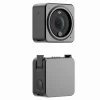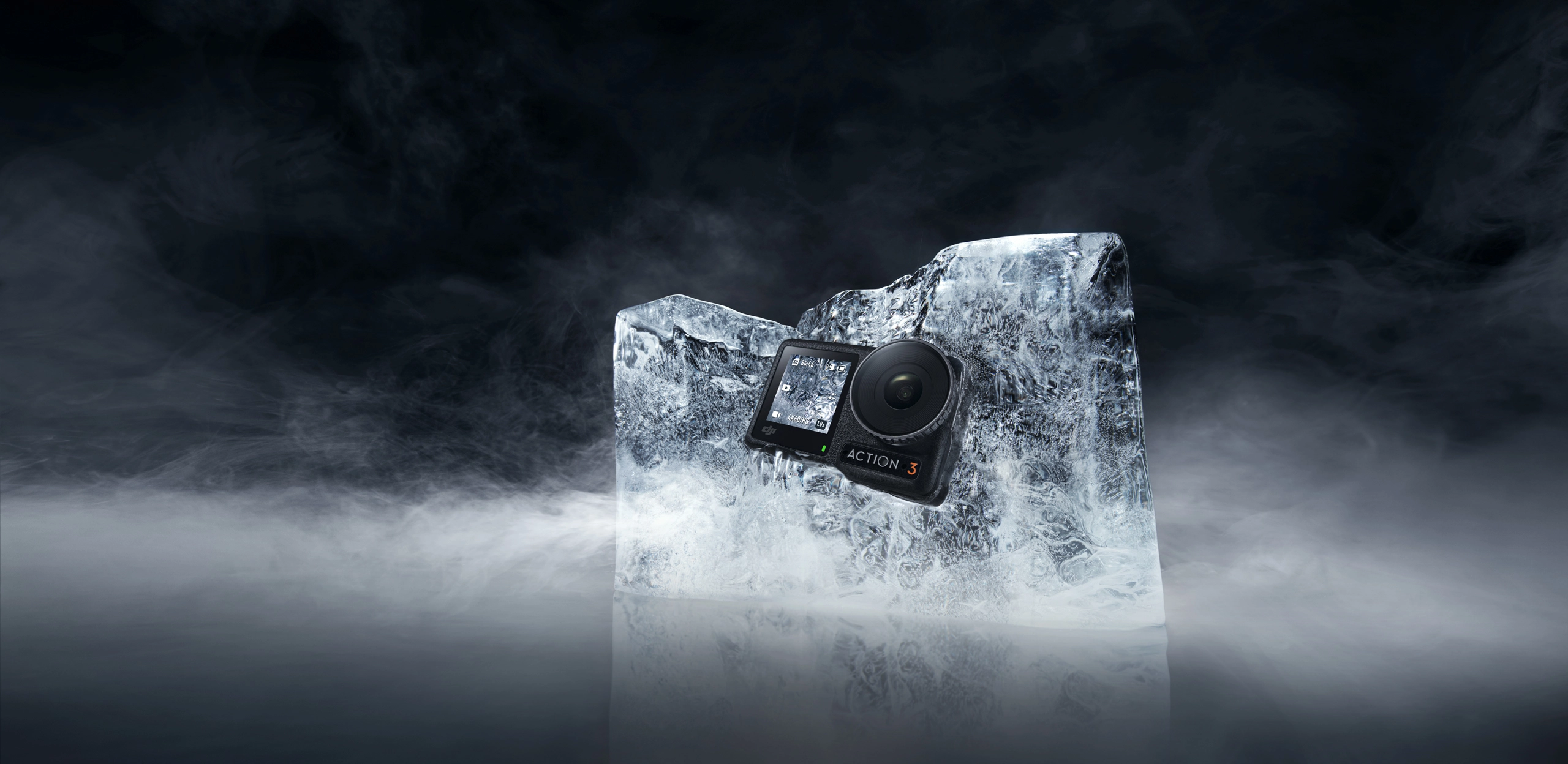
DJI has been trying for years to beat GoPro in the action camera realm.
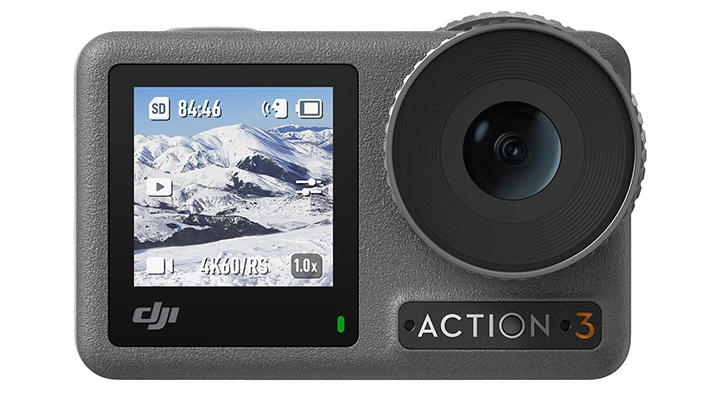
Specifications
| Dimensions | 70.5×44.2×32.8 mm |
| Weight | 145 g |
| Obstacle Detection | - |
| Integrated Camera | - |
| Video Resolution | 4K (16:9): 3840×2160@100/120fps |
| Megapixels | 12 PM |
| Media Format | MP4/MOV (AVC/H.264; HEVC/H.265) |
| Remote | No |
The best DJI Osmo Action 3 deals
Did they succeed this time around?
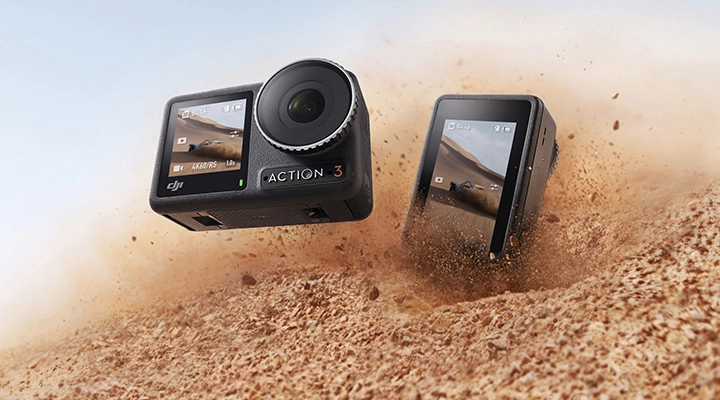
GoPro and DJI are going head-to-head on this one and while GoPro just launched its new Hero 11 Black, with a taller sensor that makes for better stabilization and support for 10-bit video, DJI is getting more serious about its action cam’s upgrades. With a full redesign, two displays, and a host of camera upgrades. DJI may actually take the throne this time around.
While last year’s Action 2 was pretty impressive with its modular design, the unusual camera brought some serious compromises, one of which was excessive overheating. With the Osmo 3, the drone manufacturer seems to have learned from its mistakes and has returned to a safer design that should be far more user-friendly and robust.
The new DJI Osmo Action 3 brings back the Osmo name and the traditional camera styling, both features missing in the last year’s DJI Action 2. This means we’ll have removable batteries, an SD card slot, and a swappable lens in this new model, making the Action 3 the true successor to the original DJI Osmo.
Although DJI dropped most of its innovations from the Action 2 due to its limitations, fortunately, they brought back the excellent mounting system of the Action 2. Adopting a combination of magnets and clamps, you may never have to use the standard mounting camera screws again. Even though Action 3‘s mounting system is fantastic, the new DJI model has more going for it than just convenient mounting. Its wide field of view is more expansive if we compare it to the GoPro Hero 11.
The Action 3 is also totally waterproof up to 16m and can be submerged 60m deeper with the extra case. The Osmo 3 is available in a great standard package that costs less than the Hero 11’s and ships with three extra batteries, multiple mounts, and extending grips right out of the box.
Although the Action 3 is a great action cam, it doesn’t win against the Hero 11 on all fronts. If we factor in the camera, the GoPro’s pictures and videos outclass Action 3‘s.
Costing less than its main competition, though, and featuring some clear highlights, the Osmo 3 is still a competitive option.
On paper, it looks like it could prove to be a real rival to GoPro‘s market dominance, so let’s find out how it measures up.
Table of Content
Design
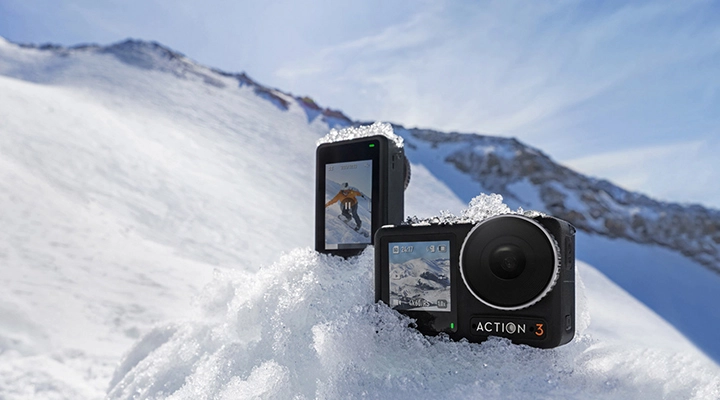
While the Action 2 boasted an innovative modular design on cuboid blocks that pair up via magnetic clamps, the Osmo 3 goes back to a far more traditional look that’s GoPro inspired.
While we could view this as a failed attempt by DJI at the modular approach, the drone manufacturer retained the magnetic clamp and used it as the basis for a superb quick-release system for fixing and unfixing the camera on first and third-party mounts. The Action 3 can use the same type of mount that the GoPros use, but you can simply unclip it each time without having to unscrew it each time. It’s a much better system than the one with screws GoPros have. However, you may find the “screw method” more reassuringly secure if you’re doing some extremely fast movement.
This camera has a mag-lock mounting point on its base, and the included Horizontal-Vertical Protective Frame (a case that can be snapped around the camera to give it an extra layer of defense.) All things considered, though, this action camera is tough. It can easily survive drops of up to 1.5m without a scratch and can be submerged up to 16m in water without a dive case (an optional dive case is available, boosting water resistance to 60m.) The lens is swappable too, so if it gets damaged, you don’t need to replace the entire camera.
Another great addition is the Gorilla Glass touchscreens on the front and back. Previous dual-screen action cams have only made the rear screen touch-sensitive, but here you can tap to adjust settings and view previously shot material on the second touch screen too. It’s a great feature, but we still almost only used the main rear screen because of its size, as the rear one is a little wider. Both screens sport a pixel density of 326PPI, are plenty sharp, and get nice and bright for easy outdoor viewing.
The camera features only two physical buttons, a large shutter button on top and a power/quick select button on the side. The latter can be used to cycle through shooting modes quickly.
Lastly, another interesting design aspect is that the DJI has used the “O” in the Action 3 logo to house a small colour temperature sensor.
Features and Battery
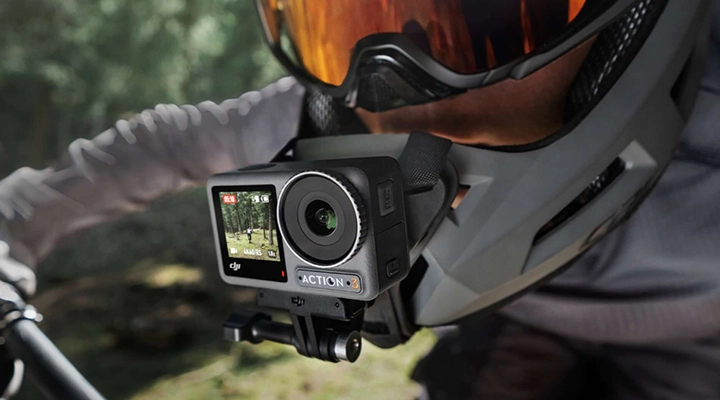
The battery is what DJI calls a 1770mAh Extreme Battery, and it’s essentially an answer to the GoPro’s Endure battery. Comparatively, DJI‘s solution offers an additional 50mAh of battery life and can withstand temperatures down to -20° celsius. The battery on the Action 3 is fantastic and far outlasts the Hero 11.
When the battery on the Action 3 does run out, you’ll be back up and running in no time thanks to its fast charging support that gives you an 80 percent charge in just 18 minutes. From zero to one hundred percent takes around 50 minutes with the DJI’s 30W USB-C charger, which is unfortunately sold separately. A standard USB-C cable is supplied in the box, though.
The regular bundle comes with a three-bay battery charging case, a neat solution for fast-charging multiple batteries simultaneously. We also love that the case has a few microSD card slots to keep your storage cards safe and handy. On top of that, the charging case also functions as a power bank, so you can top up your phone if you have an appropriate cable.
The Osmo 3 can also be used as a USB webcam that supports live streaming over WIFI. It’s nice to have a webcam functionality, but the wide field of view means it won’t look like a normal webcam.
One unique feature of the Action 3 is the InvisiStick setting. This basically masks over a selfie stick, creating an invisible stick effect that’s normally only achievable with a 360° camera. However, DJI states that it only works with snow sports.
The User’s Interface on this action cam is simple and slick, based on tapping on-screen icons and swiping from screen sides to bring up various menus. The touch system is pretty intuitive and responsive on the rear screen. Being a little too small, the front screen is harder to control generally.
After being widely criticized for its overheating issues, DJI decided to design its new action camera to distribute heat better. We still find some overheating problems on the Osmo 3, but it’s nothing compared to what Action 2 had. The Action 3 can record for longer without overheating, shooting a 16-minute 4K clip at 60FPS before stopping recording. Even when it does overheat, the camera wasn’t uncomfortably hot to the touch.
The Action 3 doesn’t have as many software capabilities as the Hero 11 Black, especially regarding photography. The Osmo 3 doesn’t even have a night mode, so the ultra-wide angle lens on your smartphone will likely capture better low-light photos than the DJI’s camera. With computational photography having come so far recently, Action 3‘s weak photo mode, especially in challenging scenes, is quite a big drawback.
Software
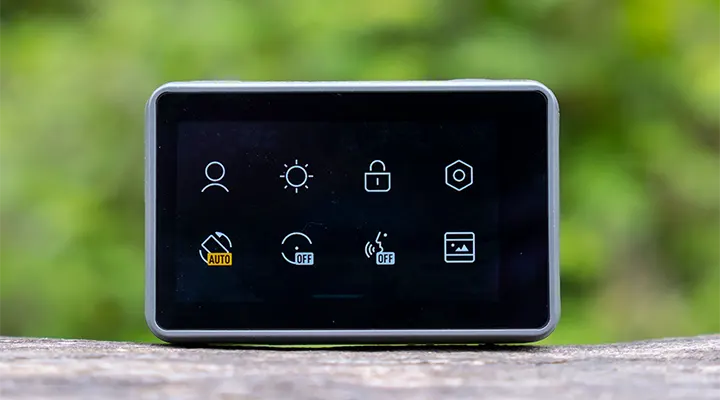
One thing the Osmo 3 edges over GoPro‘s camera is its app, DJI Mimo. DJI’s app offers big-screen control over modes, which is great, as well as a live preview of whatever you’re shooting. The overall connection stability with lower latency is fantastic too.
The app’s interface is extremely customizable. For starters, you can save up to five custom profiles to quickly switch between bespoke shooting modes. You can also add these modes to your Quick Switch command, activated by a single, short power button press. The Mimo app also offers a range of Pro features for the more tech-savvy. When capturing photos, you can shoot in JPEG or RAW, switch between a wide or standard field of views, control shutter speed, and ISO, and adjust white balance.
Pro video capture gives users control over the white balance, ISO, and shutter speed, just like Pro photo, but also offers an extra colour profile, D-Cinelike, for flatter tones that give more scope to recolour with video editing software.
Photos and Video
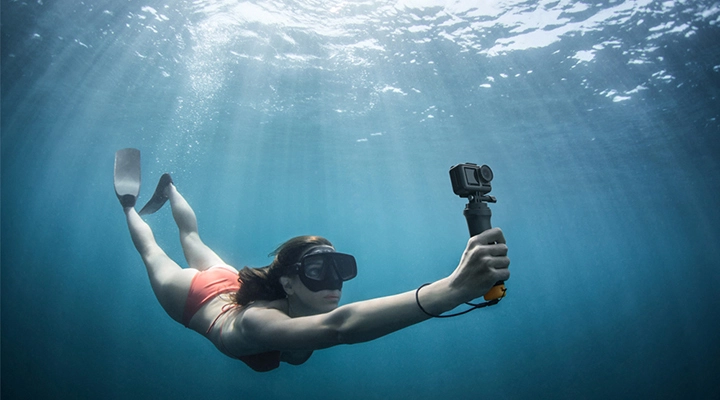
If you’ve ever tried first-hand the DJI Action 2, you’ll know what to expect from the Osmo 3. The cameras share almost the same characteristics regarding both photos and video. This means the Action 3 isn’t the best on the market, with performance missing out compared to the GoPro‘s counterpart.
The camera is based on a 1/1.7-inch CMOS sensor and an f/2.8 aperture lens with a wide-angle field of view. At 155°, it’s a much wider FOW than what GoPro models offer, which can be a big deal if you’re looking to get as much in the frame as possible.
If you mainly shoot vlogging-style content though and don’t need a super-wide 155° angle, you’d better opt for a less expensive camera. The Action 3 doesn’t prioritize faces when it exposes a scene, and it also misses out on detail picked up by its competitor’s GoPro camera.
Also, by getting more in the frame with its wider lens, DJI makes it harder to expose the image for all the elements in-frame. So, if you’re looking for a vlogging cam, this won’t cut it for you. Even if you switch out the lens to a less wide field of view, details fall off, and the camera still underexposes faces. Therefore, if your goal is to buy a vlogging action camera, we recommend either the GoPro Hero 10 or 11.
Image quality is good rather than great, with lighting being a key factor: If you record outdoors during the day, your footage from the Action 3 will look pretty sharp, detailed, and well-exposed. However, the camera quality quickly falls off when you start taking photos in trickier environments with low light conditions.
Video captured by the Action 3 is sharp and detailed, while the colours appear natural and accurate. Currently, the Action 3 lacks 10-bit colour capture, but DJI confirms it’ll be available soon via firmware update. This will allow for more flexibility in colour grading and make the DJI camera a viable alternative to the GoPro.
One good thing about the Osmo 3 is the stabilization. With the RockSteady 3.0 electronic, the stabilization is impressive. Action 3′s horizontal leveling is also super-competitive, however, it falls short compared to the one GoPro implements in their action cams. 360° horizon leveling requires that you use a resolution of 2.7K or lower, but if you want to maintain 4K recording, you can still use horizontal leveling of up to 45°. That’s an acceptable trade-off, but the Hero 11 can deliver 360° leveling at a whopping 5.4k video resolution.
At the end of the day, GoPro‘s image and video quality are objectively better, however, if you want an action camera for extreme sportspeople, the Osmo Action 3 may be a better choice.
In addition to regular 4K video shooting, the Osmo 3 can capture 12MP still photos, time-lapses, and slow-motion videos. In good lighting, stills are good, in low light, the quality drops considerably, as we discussed earlier.
Lastly, the sound quality on the Action 3 captures clean sound from its three microphones, tuning our background and wind noise relatively well. We prefer the sound quality of the Osmo 3 when compared to the GoPro Hero 11.
Price
The DJI Osmo Action 3 is available for purchase at $329 in its base model package. You also have an Adventure Combo pack for $439, which includes a ton of different mounts, a total of three batteries, a charging base for multiple batteries, and a portrait-orientation mountable housing.
Price-wise, the Osmo 3 is a much better alternative to the Hero 11, which starts at $499 for the base model.
Pros and Cons
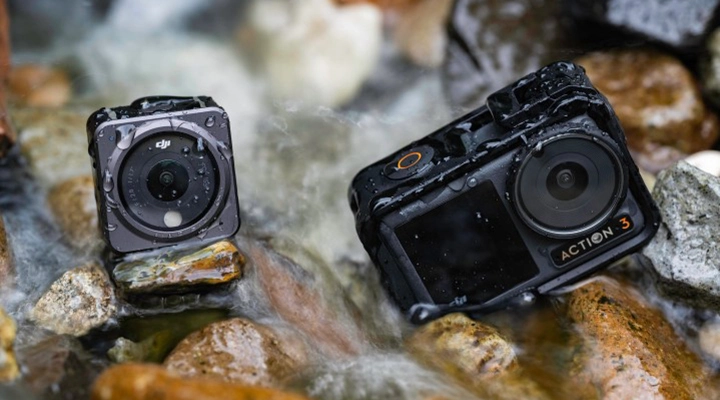
You should buy the DJI Osmo Action 3 if…
- You love diving and sports: The Action 3 is waterproof up to 16m, which makes it a better choice for divers who don’t fancy a protective case. Also, if you don’t mind using an extra case, you can go much deeper than that, with a maximum dive depth of 60m.
- You need quick mounting: GoPro‘s mounting system is still screw-based, meaning you’ll need to screw and unscrew your action cam every time. On the other hand, the Osmo 3 combines magnets and a clamping system that saves you a ton of time and hassle, as you’ll never need to screw your action camera in place ever again.
- You need a super-wide angle: Despite not having the best quality camera around, the Osmo 3 has one of the widest angles ever with its 155°. If you want an extra-wide camera angle for your portraits or landscape footage when traveling or hiking, the Action 3 might be perfect for you.
You shouldn’t buy the DJI Osmo Action 3 if…
- You’re a vlogger: As we mentioned, the Action 3 camera doesn’t recognize faces too well, especially when many elements are in the background. If you’re a vlogger or a streamer, you better look for something else.
- You’re social-media-savvy: DJI claims the Osmo 3 is perfect for TikTok and Instagram because it can be mounted vertically with a special case. But we think that DJI’s solution misses the mark with its worse camera quality when compared to the Hero 11.
- You need to shoot long clips: The Osmo 3 doesn’t like shooting long clips at its maximum 4K resolution and 60FPS. Capping at around 16 minutes and 30 seconds, it can’t beat the Hero 11, which can shoot over 28 minutes with the same quality.
- You want the best camera quality: DJI‘s software and camera quality are nowhere near the best the market of action cameras has to offer. GoPro‘s camera quality and computational photographs are leaps and bounds ahead of DJI‘s latest action cam.
Final Words
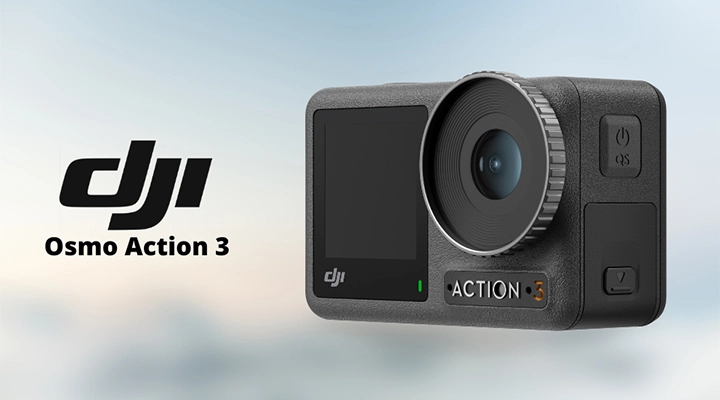
Falling short on much of the competition, the DJI Osmo 3 may not be the best action camera around, but it could be the best option for your specific needs.
It dives deeper than the competition with waterproofing up to 16m, has an extremely wide field of view, and delivers excellent battery life. While the Osmo 3 recycles the same core camera hardware we saw in the previous model, its more practical body and excellent mounting system are nothing to laugh at. So if you’re on a budget and don’t need the best-in-class image quality but want a robust, powerful, and long-lasting alternative to GoPro’s cams, DJI’s Action 3 could be your solution.The Action 3 is a fantastic action camera, however, as it stands right now, the GoPro still has a slight edge.

